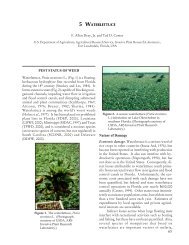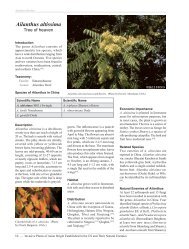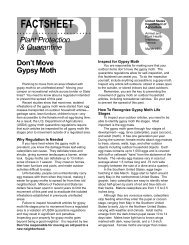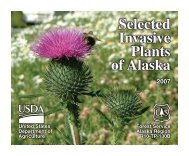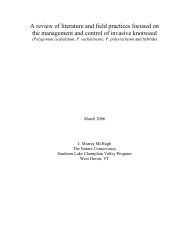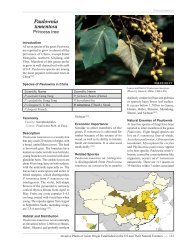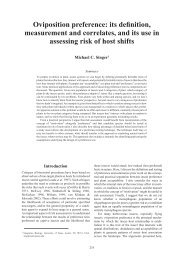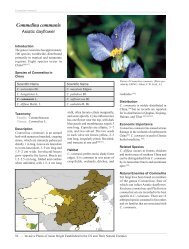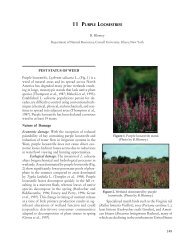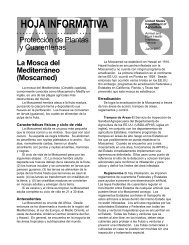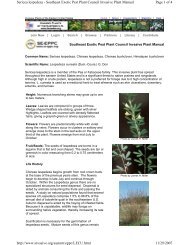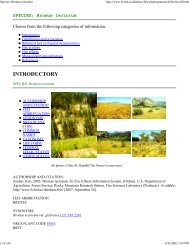A Guide to the Control and Management of Invasive Phragmites [PDF]
A Guide to the Control and Management of Invasive Phragmites [PDF]
A Guide to the Control and Management of Invasive Phragmites [PDF]
Create successful ePaper yourself
Turn your PDF publications into a flip-book with our unique Google optimized e-Paper software.
underst<strong>and</strong>ing phragmites<br />
control methods<br />
recommended management strategies<br />
fur<strong>the</strong>r information<br />
part 1<br />
part 2<br />
part 3<br />
part 4<br />
31<br />
-Long-Term <strong>Management</strong> <strong>and</strong> Moni<strong>to</strong>ring-<br />
left: Great Lakes coastal wetl<strong>and</strong> at<br />
St. Clair Flats State Wildlife Area, MI.<br />
J. Schafer<br />
To reach <strong>the</strong> goal <strong>of</strong> reestablishing <strong>and</strong><br />
res<strong>to</strong>ring native wetl<strong>and</strong> plant communities,<br />
controlling invasive species is a<br />
necessary step. Implementing selective<br />
control, as needed, will not only keep<br />
phragmites from reestablishing dominance,<br />
but also will pave <strong>the</strong> way for <strong>the</strong><br />
recovery <strong>of</strong> beneficial native species <strong>of</strong><br />
wetl<strong>and</strong> vegetation. Seeding an area after<br />
phragmites control <strong>to</strong> res<strong>to</strong>re native wetl<strong>and</strong><br />
communities typically is not necessary<br />
since native seeds normally are<br />
present in <strong>the</strong> soil. It is recommended<br />
that native vegetation be allowed <strong>to</strong><br />
reestablish naturally. However, if moni<strong>to</strong>ring<br />
determines that native plants are<br />
not responding, some sites may require<br />
seeding or planting using native genotypes<br />
<strong>to</strong> reach res<strong>to</strong>ration goals.<br />
Moni<strong>to</strong>ring <strong>and</strong> adaptive management<br />
are integral components <strong>of</strong> a successful<br />
phragmites control plan. A detailed<br />
moni<strong>to</strong>ring plan should be developed<br />
prior <strong>to</strong> implementation <strong>of</strong> control<br />
measures. Moni<strong>to</strong>ring provides <strong>the</strong> data<br />
needed <strong>to</strong> determine <strong>the</strong> effectiveness <strong>of</strong><br />
initial control efforts <strong>and</strong> <strong>the</strong> types <strong>of</strong><br />
follow-up control methods that are necessary.<br />
Moni<strong>to</strong>ring may be as simple as<br />
establishing <strong>and</strong> using fixed pho<strong>to</strong> points<br />
on <strong>the</strong> site <strong>to</strong> record changes over time,<br />
or more involved, such as comparison <strong>of</strong><br />
aerial pho<strong>to</strong>graphs taken over time or <strong>the</strong><br />
use <strong>of</strong> quantitative measurements <strong>and</strong><br />
inven<strong>to</strong>ries <strong>of</strong> vegetation using sampling<br />
grids or transects. At a minimum, each<br />
treated site should be inspected annually<br />
during <strong>the</strong> growing season.<br />
In <strong>the</strong> future <strong>the</strong>re may be an effective<br />
biological control for phragmites, just as<br />
beetles can now be used <strong>to</strong> control purple<br />
loosestrife in certain situations.<br />
Currently <strong>the</strong>re are no commercially<br />
available biological methods for <strong>the</strong> control<br />
<strong>of</strong> phragmites; however, several<br />
insects <strong>and</strong> microorganisms native <strong>to</strong><br />
Europe are known <strong>to</strong> attack phragmites.<br />
Ongoing research at Cornell University<br />
is exploring <strong>the</strong> possibility <strong>of</strong> using <strong>the</strong>se<br />
species as a means <strong>of</strong> biological control<br />
(http://invasiveplants.net).


![A Guide to the Control and Management of Invasive Phragmites [PDF]](https://img.yumpu.com/27321025/36/500x640/a-guide-to-the-control-and-management-of-invasive-phragmites-pdf.jpg)

